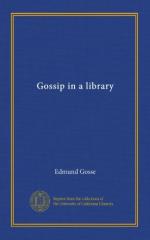There was no full memoir of Dr. Donne until it was the privilege of the present writer, in 1900, to publish his Life and Letters in two substantial volumes. Since then, in 1912, his Poetical Works have been edited and sifted, with remarkable delicacy and judgment, by Professor Grierson. It is now, therefore, as easy as it can be expected ever to be to follow the career of this extraordinary man, with all its cold and hot fits, its rage of lyrical amativeness, its Roman passion, and the high and clouded austerity of its final Anglicanism. Donne is one of the most fascinating, in some ways one of the most inscrutable, figures in our literature, and we may contemplate him with instruction from his first wild escapade into the Azores down to his voluntary penitence in the pulpit and the winding-sheet.
GERARD’S HERBAL
THE HERBALL or General Historie of Plantes. Gathered by John Gerarde, of London, Master in Chirurgerie. Very much enlarged and amended by Thomas Johnson, citizen and apothecarye of London. London, Printed by Adam Islip, Joice Norton, and Richard Whitakers. Anno 1633.
The proverb says that a door must be either open or shut. The bibliophile is apt to think that a book should be either little or big. For my own part, I become more and more attached to “dumpy twelves”; but that does not preclude a certain discreet fondness for folios. If a man collects books, his library ought to contain a Herbal; and if he has but room for one, that should be the best. The luxurious and sufficient thing, I think, is to possess what booksellers call “the right edition of Gerard”; that is to say, the volume described at the head of this paper. There is no handsomer book to be found, none more stately or imposing, than this magnificent folio of sixteen hundred pages, with its close, elaborate letterpress, its innumerable plates, and John Payne’s fine frontispiece in compartments, with Theophrastus and Dioscorides facing one another, and the author below them, holding in his right hand the new-found treasure of the potato plant.
This edition of 1633 is the final development of what had been a slow growth. The sixteenth century witnessed a great revival, almost a creation of the science of botany. People began to translate the great Materia Medica of the Greek physician, Dioscorides of Anazarba, and to comment upon it. The Germans were the first to append woodcuts to their botanical descriptions, and it is Otto Brunfelsius, in 1530, who has the credit of being the originator of such figures. In 1554 there was published the first great Herbal, that of Rembertus Dodonaeus, body-physician to the Emperor Maximilian II., who wrote in Dutch. An English translation of this, brought out in 1578, by Henry Lyte, was the earliest important Herbal in our language. Five years later, in 1583, a certain Dr. Priest translated all the botanical works of Dodonaeus, with much greater fulness than Lyte had done, and this volume was the germ of Gerard’s far more famous production. John Gerard was a Cheshire man, born in 1545, who came up to London, and practised there as a surgeon.




